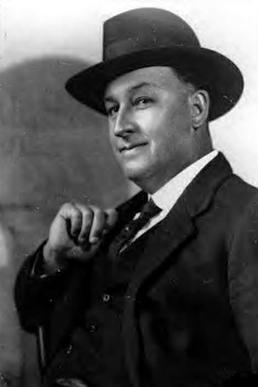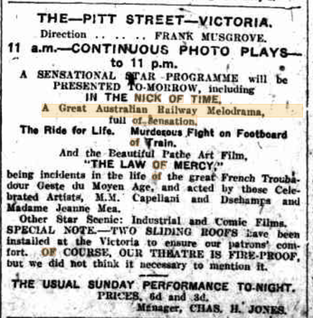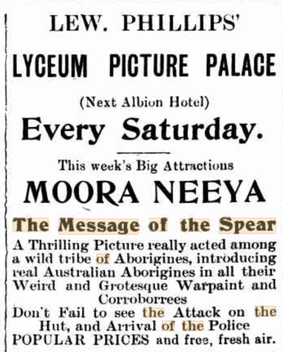Related Research Articles

John F. Gavin was a pioneer Australian film actor and director, one of the early filmmakers of the 1910s. He is best known for making films about bushrangers such as Captain Thunderbolt, Captain Moonlite, Ben Hall and Frank Gardiner. Known informally as 'Jack', Gavin worked in collaboration with his wife Agnes, who scripted many of his films.

Raymond Longford was a prolific Australian film director, writer, producer, and actor during the silent era. Longford was a major director of the silent film era of the Australian cinema. He formed a production team with Lottie Lyell. His contributions to Australian cinema with his ongoing collaborations with Lyell, including The Sentimental Bloke (1919) and The Blue Mountains Mystery (1921), prompted the Australian Film Institute's AFI Raymond Longford Award, inaugurated in 1968, to be named in his honour.

Moonlite is a 1910 bushranger film about Captain Moonlite, played by John Gavin, who also directed. It was also known as Captain Moonlite and is considered a lost film.
Ben Hall and his Gang is a 1911 Australian film about the bushranger Ben Hall, played by John Gavin, who also directed. It is considered a lost film.
Agnes Gavin (1872–1947), was an Australian actor and screenwriter in the silent film era. She worked in collaboration with her husband John Gavin throughout her career. She wrote the majority of his films and was arguably the first specialist screenwriter in the history of the Australian film industry. In newspapers she was advertised as the "well known picture dramatizer" and was praised for creating "cleverly constructed stories". Many of her films are considered lost.
The Mark of the Lash is a 1911 Australian silent film. It is a convict-era melodrama made by the husband-and-wife team of John and Agnes Gavin.
The Drover's Sweetheart is a 1911 film from the team of Agnes and John Gavin.
Keane of Kalgoorlie, or a Story of the Sydney Cup is a 1911 Australian silent film set in the racing and gambling circles of Sydney, based on a popular play by Edward William O'Sullivan and Arthur Wright, adapted from the novel by Wright.
Assigned to his Wife is a 1911 Australian silent film from director John Gavin. It is a convict-era "military romantic melodrama".

Alfred Rolfe, real name Alfred Roker, was an Australian stage and film director and actor, best known for being the son-in-law of the celebrated actor-manager Alfred Dampier, with whom he appeared frequently on stage, and for his prolific output as a director during Australia's silent era, including Captain Midnight, the Bush King (1911), Captain Starlight, or Gentleman of the Road (1911) and The Hero of the Dardanelles (1915). Only one of his films as director survives today.

Captain Midnight, the Bush King is a 1911 Australian silent Western film about the fictitious bushranger Captain Midnight. It was the directorial debut of actor Alfred Rolfe. The film is based on the play of same name by W. J. Lincoln and Alfred Dampier. Captain Midnight, the Bush King is now considered lost.
The Life of Rufus Dawes is a 1911 Australian silent film based on Alfred Dampier's stage adaptation of the 1874 novel For the Term of His Natural Life produced by Charles Cozens Spencer.

The Lady Outlaw is a 1911 Australian silent film set in Van Diemen's Land during convict days.

In the Nick of Time is a 1911 Australian silent film directed by Alfred Rolfe. It was described as a "sensational railway drama", although now is considered a lost film.
The Cup Winner is a 1911 Australian silent film directed by Alfred Rolfe. It is set against a backdrop of horseracing and the finale involves real footage from the 1911 Melbourne Cup.
Cooee and the Echo is a 1912 Australian silent film directed by Alfred Rolfe. It is considered a lost film.
Charles Villiers was an Australian actor and occasional director who appeared in many silent films. According to a contemporary report, "there is probably no actor in Australia that has done more consistent picture work than Mr. Villiers, both as heavy lead, and director." He was particularly well known for playing villains.

Dan Morgan is a 1911 Australian film from Charles Cozens Spencer about the bushranger Daniel Morgan. It was said to be starring "Alfred Rolfe and company". Rolfe directed three movies for Spencer, all starring himself and his wife Lily Dampier so there is a chance he may have directed this one and that it starred his wife. A prospectus for the Australian Photo Play Company said he directed it. It is considered a lost film.

Stanley Sadler Crick was an Australian film producer, distributor and politician. He joined the Melbourne office of Pathe Freres and became manager of the Sydney branch in 1909. He went into production, first in partnership with Herbert Finlay then helping establish the Australian Photo-Play Company.

Moora Neeya, or the Message of the Spear is a 1911 Australian silent film which was the first Australian movie to emphasise aboriginal people or "the first full Australian aboriginal drama yet produced."
References
- ↑ "QUOTA FAVORED". The Sun . No. 5259. New South Wales, Australia. 15 September 1927. p. 14 (FINAL EXTRA). Retrieved 2 December 2023– via National Library of Australia.
- 1 2 3 4 "THE AUSTRALIAN PHOTO.-PLAY COMPANY, LIMITED". The Sydney Morning Herald . National Library of Australia. 14 June 1911. p. 17. Retrieved 20 February 2012.
- ↑ "Australian Notes", The Moving Picture World 18 November 1916 p 996 accessed 20 November 2014
- ↑ "FINANCIAL". The Sydney Morning Herald . National Library of Australia. 2 June 1911. p. 11. Retrieved 21 November 2014.
- ↑ "Advertising". The Sydney Morning Herald . National Library of Australia. 3 June 1911. p. 4. Retrieved 20 February 2015.
- ↑ Everyones, Everyones Ltd, 1920, retrieved 30 May 2018
- 1 2 3 4 Graham Shirley and Brian Adams, Australian Cinema: The First Eighty Years, Currency Press 1989 p 40
- ↑ "Advertising". The Advertiser . Adelaide: National Library of Australia. 19 August 1911. p. 20. Retrieved 21 November 2014.
- ↑ "Advertising". The Referee . Sydney: National Library of Australia. 18 October 1911. p. 16. Retrieved 13 September 2013.
- ↑ "THE MOVING PICTURE WORLD". The Referee . Sydney: National Library of Australia. 5 July 1911. p. 16. Retrieved 20 February 2015.
- ↑ "Advertising". The Sydney Morning Herald . National Library of Australia. 30 September 1911. p. 3. Retrieved 8 June 2015.
- ↑ "MOVIE "HEAVY" CHATS LIGHTLY". The Winner. Melbourne: National Library of Australia. 22 December 1915. p. 12. Retrieved 15 November 2014.
- ↑ "PHOTO PLAYS". The North Western Advocate and the Emu Bay Times . Tas.: National Library of Australia. 27 July 1911. p. 1. Retrieved 19 November 2014.
- ↑ "Governor-General in Brisbane". The Western Star and Roma Advertiser . Toowoomba, Qld.: National Library of Australia. 17 July 1909. p. 2. Retrieved 14 September 2013.
- ↑ "NO. 2 JURY COURT". The Sydney Morning Herald . National Library of Australia. 22 November 1911. p. 7. Retrieved 21 November 2014.
- ↑ "DISTRICT COURT". The Sydney Morning Herald . National Library of Australia. 11 September 1912. p. 8. Retrieved 21 November 2014.
- ↑ "The Future of Australian Pictures AN INTERVIEW WITH ALEX. HELLMRICH.", Everyones., 4 (261 (4 March 1925)), Sydney: Everyones Ltd, 1920, nla.obj-559978517, retrieved 30 November 2023– via Trove
- ↑ "GENERAL GOSSIP". The Referee . Sydney: National Library of Australia. 20 March 1912. p. 16. Retrieved 8 June 2015.
- ↑ "Advertising". The Newsletter: an Australian Paper for Australian People . Sydney: National Library of Australia. 21 December 1912. p. 6. Retrieved 14 September 2013.
- ↑ "Advertising". The Referee . Sydney: National Library of Australia. 7 February 1912. p. 16. Retrieved 14 September 2013.
- ↑ Andrew Pike and Ross Cooper, Australian Film 1900–1977: A Guide to Feature Film Production, Melbourne: Oxford University Press, 1998, 21
- ↑ "THE MOVING PICTURE WORLD". The Referee . Sydney: National Library of Australia. 12 July 1911. p. 16. Retrieved 20 February 2015.
- ↑ "AMUSEMENTS". The Mercury . Hobart, Tas.: National Library of Australia. 1 November 1911. p. 3. Retrieved 8 June 2015.